-
Car Reviews
- All reviews
- Midsize SUVs
- Small cars
- Utes
- Small SUVs
- Large SUVs
- Large cars
- Sports SUVs
- Sports cars
- Vans
Latest reviews
- Car News
-
Car Comparisons
Latest comparisons
- Chasing Deals
With many Australians still wary of going all-in on a pricey and unfamiliar electric vehicle, is the Mitsubishi Outlander PHEV actually a strike of brilliance?
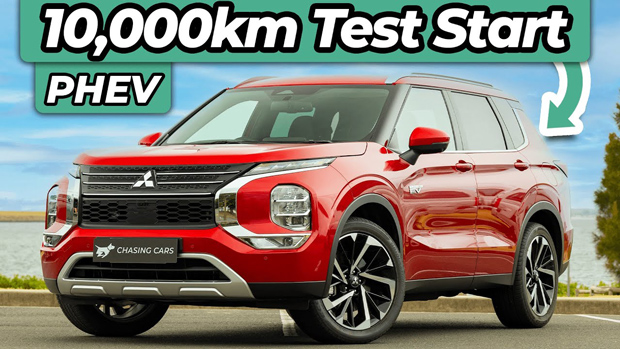
It’s taken years for Australians to sit up and take notice of plug-in hybrids, which are prolific in Europe and other parts of the world, and this is despite a seemingly insatiable demand for self-charging or series-parallel hybrid vehicles.
Yes, for many Aussies there is just something about plugging the damn thing in that makes it all seem a bit like hard work. But our slack nature isn’t all to blame, as PHEVs have historically had small batteries with equally small ranges that doesn’t always bode well for big-country living.
The outlier in this situation has long been the Mitsubishi Outlander PHEV, which not only proved to be genuinely efficient in the real world but also presents a tantalising ownership proposition overall, a combination that made the last (and first) generation the best-selling plug-in anywhere in the world.
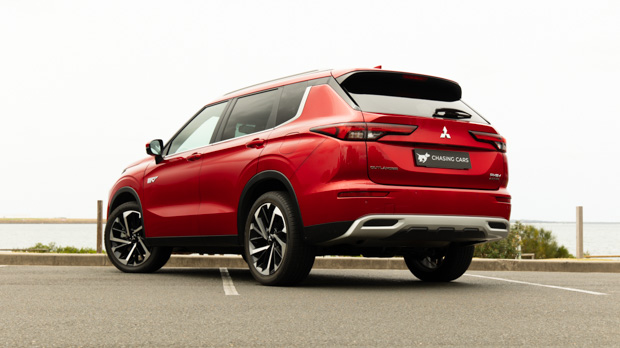
Just as the old Outlander was beginning to look a bit tired, a new generation was thrust upon in late 2021, offering a modernised take on the midsize SUV that doubled down on what made the breed great and even brought something special back to the Mitsubishi brand. And the PHEV version arrived more recently, in August this year.
Most notably, the latter’s battery size grew from 13.8kWh to 20kWh and the electric motors became more efficient, a combination that Mitsubishi says allowed the electric driving range to grow substantially from 54km to 84km.
Engineers also set about making the Outlander PHEV quite a bit more powerful, with the 85kW front and 100kW rear motors offering a significant step up from the old 60kW/70kW duo.
Working in conjunction with a 98kW 2.4-litre petrol engine, the trio produces a potent 185kW and 450Nm – that’s near hot hatch levels of grunt.
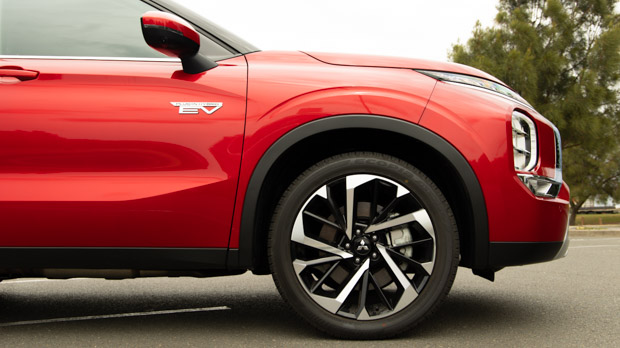
But why is it here, in the Chasing Cars garage, and for a six-month tenure?
Electric vehicles are rapidly growing in popularity here in Australia but their appeal remains limited due to a lack of long-distance driving chops, the high price of entry and sheer unfamiliarity to most buyers. All of which is improving, if slowly.
So if EVs are the car of tomorrow, then is the Outlander PHEV the car of today? The form guide suggests that it has enough electric driving range to easily tackle the urban work run without using a drop of fuel and it appears affordable enough for many families to buy and run.
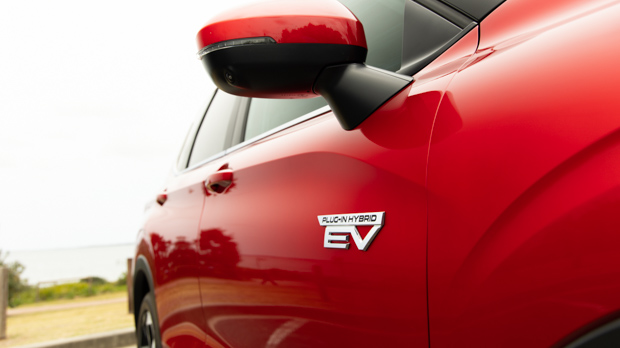
More importantly, the assistance of the petrol engine means it still has the legs – around 800km worth, says Mitsubishi – for serious and potentially hassle-free grand touring, which is a big lure for weekend adventurers like me.
The Outlander PHEV is one of a few plug-in hybrids on sale, with the significantly more expensive Peugeot 3008 and incoming Mazda CX-60 joining it for company in its midsize SUV segment. That said, it’s really the likes of the Toyota RAV4 Hybrid that will keep Mitsubishi up at night.
A recent price increase of between $1000 and $1500 for in-bound MY23-badged models has raised the price of entry up to $55,490 (before on-road costs) for the entry-level ES but we’ve opted for the Aspire in Red Diamond ( a $940 extra), which represents a bit of a sweet spot in the range given its long list of features and $61,990 ask – though as ours in an MY22 model it comes in slightly cheaper at $60,990.
These include:
For those wanting a bit extra they can opt for the Exceed at ($67,490), which throws in two extra seats to become a seven-seater and brings quilted-leather upholstery, pull-up sunshades and three-zone climate control.
However, the flagship remains the Exceed Tourer which is slightly more expensive ($69,990) but offers some seriously luxurious features such as massage seats, high-grade leather upholstery, heated seats in the second row and a two-tone paint job.
As the Outlander PHEV features the handy ability of running on either petrol or electricity, running costs when charging at home will be calculated at the rate of $0.25/kWh, while public chargers and fuel will be logged at the purchased rate.
For the next six months and 10,000km production manager Tom Place will be putting ‘his’ Outlander PHEV Aspire to the test to discover what it’s really like to live with day to day.
We plan to test every aspect of this Outlander PHEV during this time and are keen to hear any ideas you may have, so feel free to reach out to us via email or on social media.
After six months it’s come time for the Outlander Aspire PHEV to leave the Chasing Cars garage. It was my first long-termer as a family man and an experience I’ll never forget.
Myself and the team have done some serious kays in this Outlander, over 11,000km in fact. It had travelled from our office in Sydney to as far north as Queensland and down as far south as Mitsubishi Australia’s home in Adelaide.
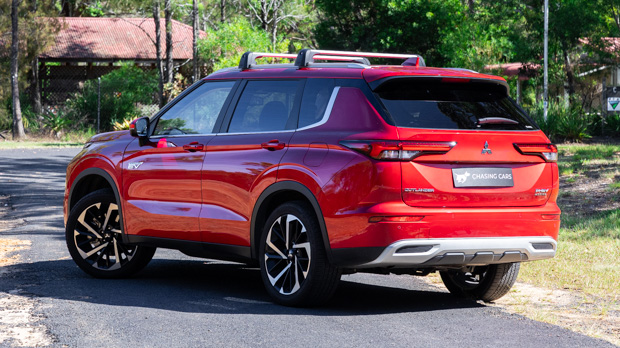
Most of its use, however, has been serving the unremarkable and thankless everyday duties of a family car, a role in which it has largely excelled.
As I have a young child who requires a rearwards-facing baby seat, a sizeable back seat is a must and the Mitsubishi has room to spare. My wife never once had to move her seat from its natural position and the wide-opening doors also made getting babies out very easy.
Good cabin visibility along with standard-fit rear tinted windows (in our Aspire), along the clever seat back pockets in the backseat show that Mitsubishi has a good understanding of what buyers appreciate in a family car long term, not just the shiny gadget that piques interest in the showroom.
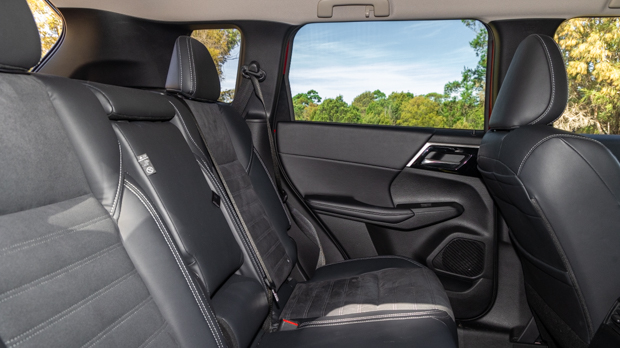
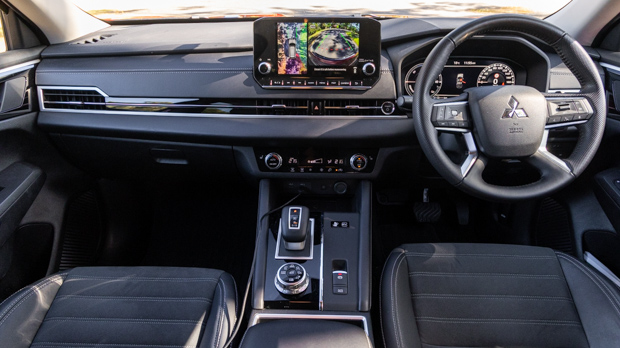
Furthermore, I was brought genuine peace of mind by the fact the Outlander is one of the newest and safest midsize SUVs on the market; with modern innovations such as a front-centre airbag plus reversing AEB, which is great for the wellbeing of active yet inattentive kiddos.
The generous space continues up front as well, where the commitment to user-friendly physical controls for the climate control and other functions is very welcome.
The near-silent driving demeanour of the PHEV is also a constant perk over many of its rivals such as the RAV4, which use their noisy petrol engines far more frequently in comparison.
The Outlander is also fundamentally screwed together well; and it’s worth noting that I encountered zero rattles, creeks or any technical glitches with any of the technology across my tenure. That’s a feat not achieved by my past Toyota Yaris Cross and Subaru Outback long termers.
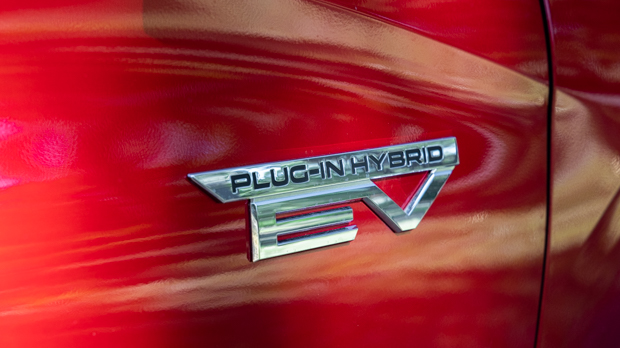
Still, there is room for improvement.
Some of the gloss black plastics wore predictably poorly and developed scratches over time, or at least spent most of the time covered in fingerprints, which cheapened the overall appearance.
The 494-litre boot is also just okay for family needs. Further, the fact that the Outlander PHEV lacks a spare tyre of any kind really hampered a sense of confidence when used for grand touring duties.
I also think that, at circa-$68,000 driveaway, the front passenger deserves power seat adjustment. And while the Aspire does fit adaptive cruise control you only get the fully-fledged stop-and-go low-speed system on the Exceed and above, which is a real pest if you spend as much time in traffic as I do.
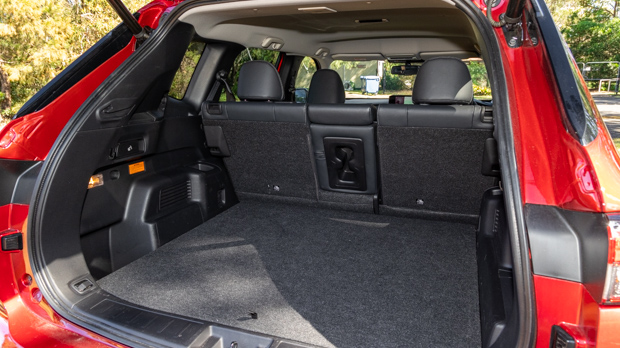
Although I’ve come to really enjoy the way the Outlander drives in a straight line, I also do have some issues with the way the car handles.
I could get hyper technical here but, in short, the ride is best described as ‘floppy’. If I thread the Outlander in and around a roundabout, both car and driver feel tossed from one side to the other far quicker than they should.
This seems to be a bit of an overcompensation for the overly-firm nature of the petrol variant but with its extra weight, the PHEV is still a bit uncomfortable at times on the Aspire’s 20-inch wheels.
I’ve sampled the lower-spec ES PHEV on 18s and while that variant is a lot more comfortable, you do pay for it in a body control, which becomes even more unwieldy. For the record, Mitsubishi lets you mix-and-match wheels between grades, which is lovely.
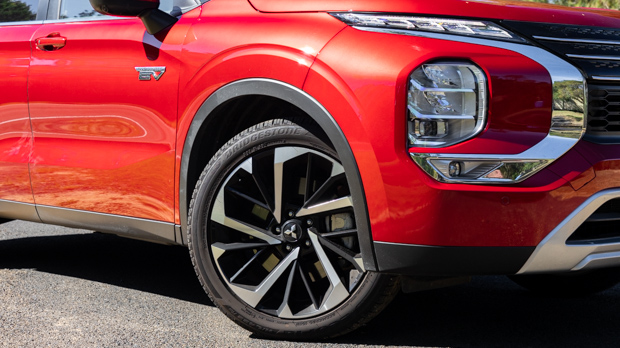
It seems the ideal choice here may be 19s, an option offered on the mechanically related Nissan X-Trail but not yet on the Outlander. Some adaptive dampers would also be a fantastic fit on the PHEV, especially considering the premium you’re paying.
But for now, I’d still very much recommend the 20s over the 18s as the control vs comfort balance is simply better.
Asking what sort of fuel economy you are getting in a plug-in hybrid feels a bit of a ‘how long is a piece of string’ sort of question, as the answer will highly depend on how often the driver charges the car.
After all, if the driver charges it every day and never goes beyond the EV range it would be 0.0L/100km. And if they never charge the car, consumption can get quite high indeed.
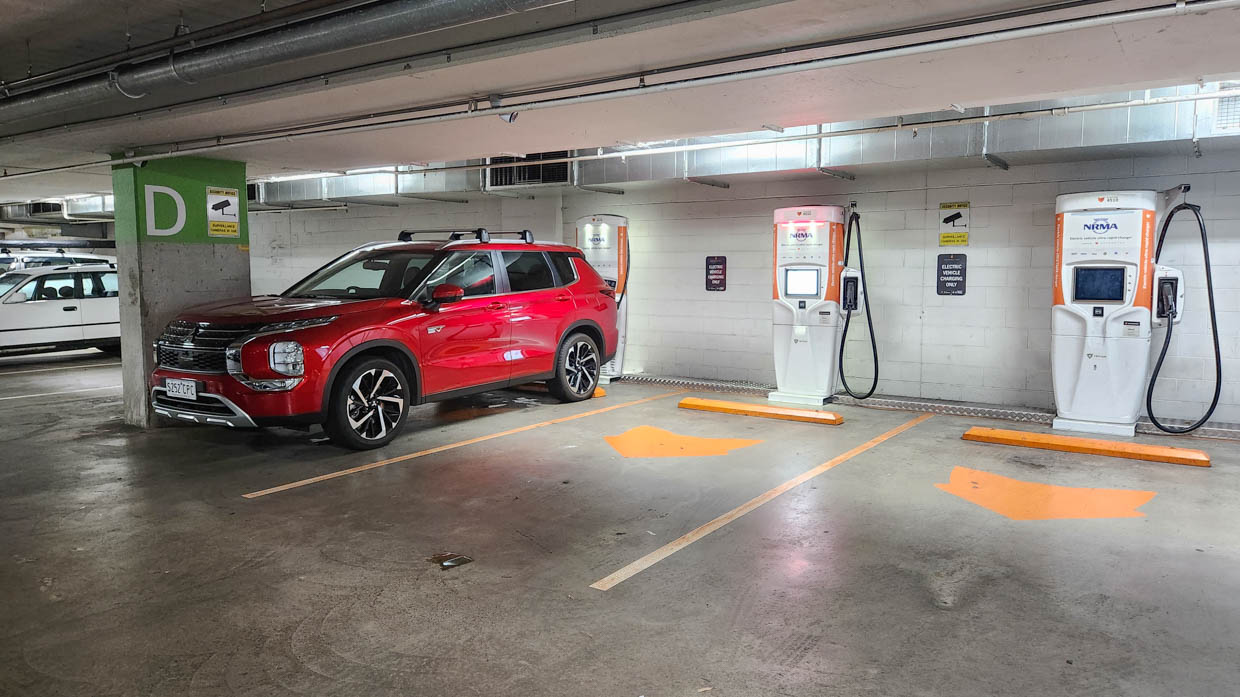
Pictured: the Outlander PHEV at the sole working charger at this three-strong station in central Sydney
During my usage, which typically involved some occasional stints of daily charging and a concerted effort to nab as much public charging time at the shops as possible, I saw an average of 6.9L/100km.
I’ll footnote that last point by stating I haven’t been able to access public charging nearly as often as I would have liked as the reliability of the Australian public charging network – particularly that of Chargefox – has been woefully inadequate.
Public chargers are often hard to use, plagued by glitches or simply just not working for weeks or months at a time.
So let’s face it, a lot of you aren’t going to keep the Outlander PHEV fully charged all the time, so is it still efficient, even with a flat battery?
During my time driving the Outlander on a flat battery, I’ve seen efficiency of around 6.5L/100km in urban areas and 8.3L/100km on the highway. Those numbers aren’t world-breaking, and as we discovered in the twin test against the RAV4, the circa 400kg weight penalty over the Toyota is likely the main culprit here.
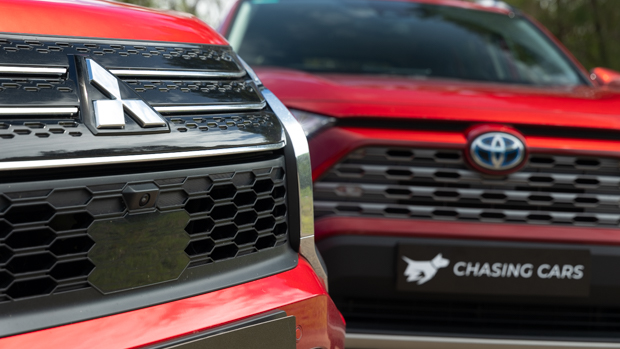
Thankfully, though, the Outlander has an impressive fully-electric range which, as I previously discussed, stretches up to 92km in optimal conditions, though it will easily do around 60 to 74km on a single charge.
I’ve sampled a great many Outlanders in both petrol and PHEV guise since the new generation made its debut and I’ve come to believe that the best one to buy is, well, this one.
In Aspire trim, the Outlander is great value compared to the other PHEV grades. It tricks all of the needs and most of the wants. Beyond this grade, the return on investment diminishes.
I’m also of the belief that the PHEV, with its monstrous grunt, added refinement and zero-tailpipe emissions capability, is much more recommendable than the petrol version, which struggles to justify itself against its accomplished rivals.
So should you buy an Outlander? Well, that depends on who you are.
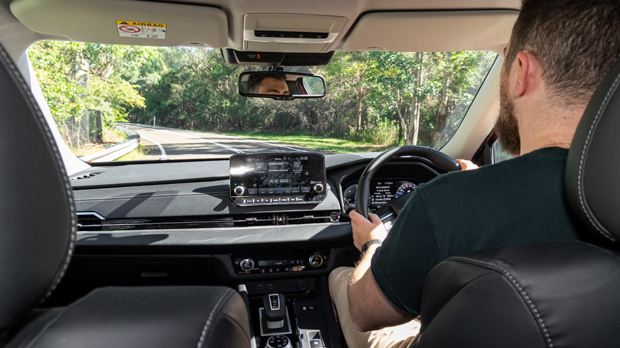
If you are the type of person who will be able to charge up the Outlander at least a few times a week, be that at work or home, then yes the darling of the diamond brand may very well be a good fit for your lifestyle, allowing you to enjoy the benefits of an EV most of the time without the limitation of driving range.
But if you don’t live or work in a place where you can charge the Outlander PHEV it will prove almost impossible to make up the $15,000-ish premium between it and the petrol version as the plug-in will simply not be very efficient. The Nissan X-Trail E-Power or Toyota RAV4 Hybrid will be better picks in this situation.
I’m sad to watch our Outlander PHEV go but in truth I belong to the latter camp and thus it was not a good fit for me. Even still, with this midsizer, Mitsubishi has a model it can be proud to place in the centre of its lineup.
Mitsubishi says buyers wanted more range in the new-generation Outlander PHEV, so does it really reach the impressive 84km benchmark that it claims?
During my recent trip back to Adelaide I was finally able to do something that I haven’t been able to do at my Sydney apartment: plug the damn thing in at home.
When it comes down to it, this is how the Outlander PHEV is designed to and should be used.
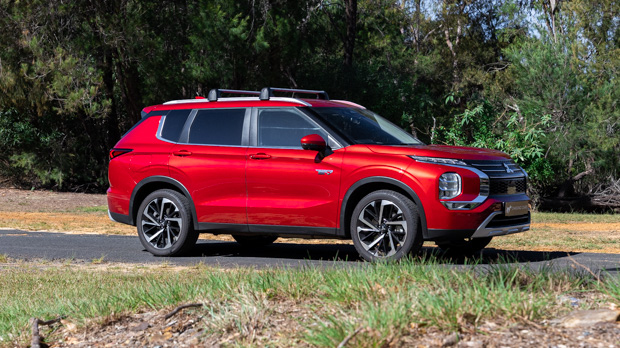
In my experience, public charging facilities have proved too inconvenient to use often, thanks to chargers either being broken or accompanied by other vehicles and their (occasionally) ill-mannered owners.
Furthermore, with the Outlander’s small battery (measuring 20kWh gross or roughly 16kWh usable) it’s very easy to burn 20 percent of your energy diverting your route from home or work to travel find your nearest charger; essentially making the whole exercise a bit of a fool’s errand.
But for two and a half weeks, I was able to live the ‘ideal’ PHEV lifestyle. In total I topped up the battery at least 15 times. And thanks to Mitsubishi’s in-built charging time settings, I was even able to maximise my top-ups during the cheaper off-peak hours, most of it at least.
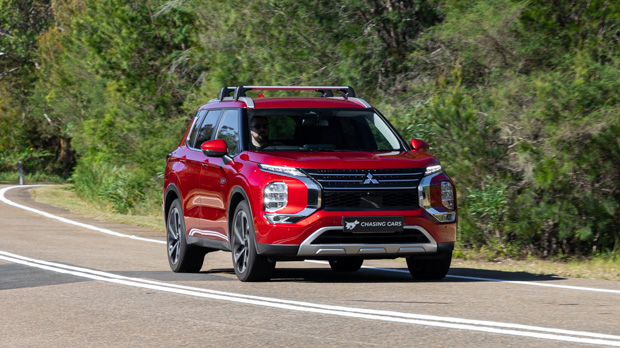
South Australia has a pretty stingy off-peak window of just six hours (1 to 6am) – and it takes over nine hours to recharge the Outlander from a standard three-pin socket with the provided charger, so I wasn’t able to do all my charging within this period.
Other states are more generous with their off-peak hours and the driving range of the Outlander PHEV is ample enough that you may not need a full recharge every day.
I wasn’t able to get through a single day without recharging but then I’ve always preferred the company of a steering wheel and pedals over a TV remote and couch when on holidays.
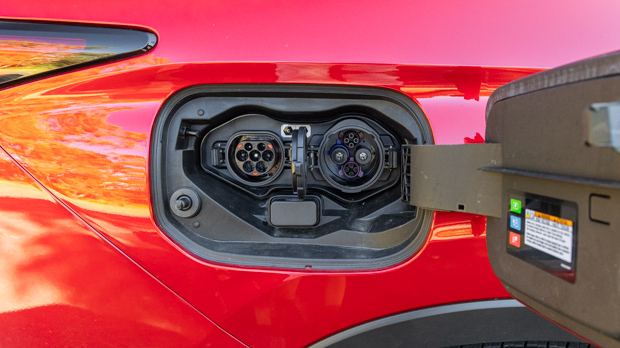
During my many journeys I saw a range of between 60 to 74 kilometres when running the Outlander in ‘EV’ mode but given that all my trips started with a short highway blast on the edge of the aptly named Adelaide Hills, this wasn’t all that surprising.
Regardless, this result falls short of the 84km claim quoted by Mitsubishi. I should point out though that figure is tested according to the NEDC standard which we at Chasing Cars typically avoid due to its lenient testing conditions, but no WLTP figure is available for Australia at this time.
But personally, having a number like that hanging over my head irks me something chronic. Perhaps it’s my competitive nature, but I wanted to see if it was possible, even if the conditions weren’t ideal.
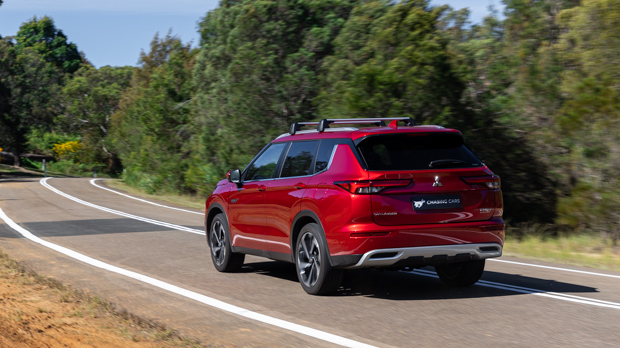
So, in the name of science, I found myself in my driveway at 4am stripping the Outlander PHEV of its roof racks, taking out all unnecessary cargo and bumping up the tyre pressures to maximise the rolling resistance.
The purpose of getting up at this ungodly hour was to avoid Sydney traffic on its famous ‘ring roads’ that loop the city – at least that was the theory.
Thankfully the saturation of my fellow motorists didn’t hugely hinder me from my main goal, as I was able to keep the Outlander PHEV in the 60 to 80km/h speed zone which cars are often their most efficient. Regeneration was turned up high while music and aircon were set low.
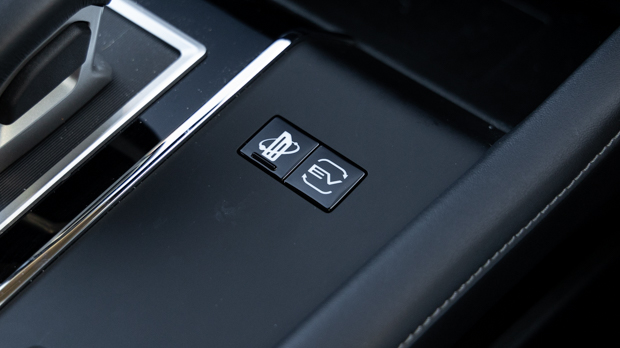
The result was a quite staggering 92km travelled before the battery was exhausted and I’m confident that I could have clawed my way into triple digits if I hadn’t found myself stuck in a traffic jam once the sun rose.
More than anything, this test was a reminder that – just like combustion cars – efficiency and range are highly dependent on when, where and how you’re driving.
So if you’re wondering if that numeral range figure on a flash new EV or PHEV is ‘enough’ for your needs, perhaps remember to be specific about what those needs actually entail.
It’s the question that has plagued my entire ‘ownership’ with the Outlander PHEV: does it actually beat the market-leading Toyota RAV4 Hybrid in a head-to-head competition?
I’ll admit, I’ve been mightily impressed with many aspects of the Mitsubishi Outlander PHEV in my four months behind the wheel, such as the whisper-quiet and smooth drivetrain, the build quality and family-friendly design. It all makes for a great package.
But, good grief, $16,250 is a lot of money to opt for a hybrid over the petrol on this Aspire grade and in setting such a price Mitsubishi has set itself a huge challenge to justify the extra spend, especially when the market-leading Toyota RAV4 only charges just $2500 extra against the roughly comparable petrol GXL grade.
So can the Mitsubishi PHEV justify that extra spend? Well, to find out I decided to pit my Outlander in a head-to-head fuel economy loop against its natural hybrid rival from Toyota.
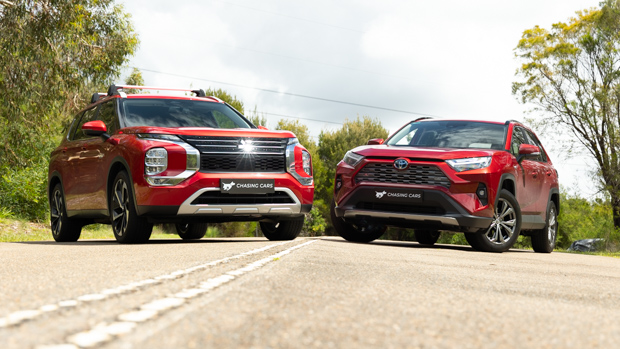
Both cars ran a combined highway and urban loop stretching just over 100km, and did so at the same time in the same realistic conditions. This meant music was playing and the aircon was on – and for the record, I did take off the Mitsubishi’s roof racks!
To leverage the strengths of each in a fair manner, the Outlander would start each loop with a fully charged (roughly 16kWh usable) battery.
For this test, we also did things properly and measured it based on how much fuel was actually drawn from the tank at the end of each loop by noting how much petrol went back in until the pump trigger clicked for the second time.
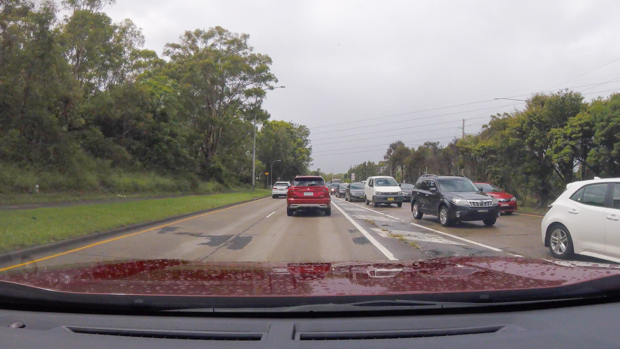
It’s a method we’ve found to be far more accurate than simply banking on the often optimistic trip computer readings, and most recently delivered us some interesting results when we compared hybrid, diesel and petrol versions of the Hyundai Santa Fe.
Deputy editor Curt Dupriez, who took the helm of the RAV4 on the day, and I both chose the circa-100km distance very carefully.
If the duration was too short, the Outlander might get away without using a drop of fuel, given I’ve seen it travel 60-74kms on electric power alone. But if the chosen route was too long, the 400kg weight deficit of the Mitsi (owing to its bigger battery) would make the game one-sided.
As you can imagine, the Outlander didn’t use all that much fuel for the first two-thirds of each loop, coasting along quite happily until its petrol engine finally kicked in while using a combined average of 3.76L/100km, costing $6.99 in fuel.
The RAV4 was predictably brilliant during this test and only used a touch more fuel with an average of 4.39L/100km and costing $8.17 – and that’s despite not requiring any charging during the test.
So is the Outlander the winner? Not so fast, as we need to include the cost of electricity the Outlander used.
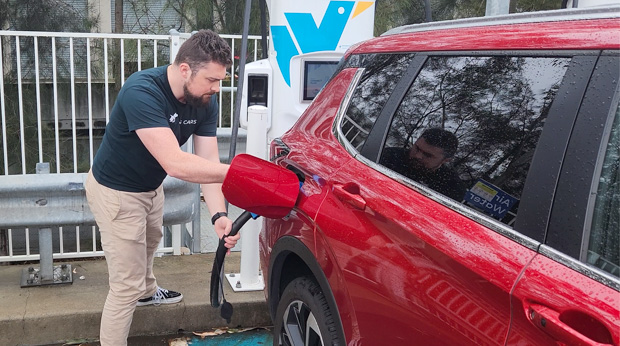
For the sake of time, we used public fast-charging facilities during our test but if we factored this into the cost breakdown, it would blow the Outlander out of the water, as it cost around $10 per 100km in combined electricity and fuel outlay.
However, Mitsubishi tells us that most Outlander PHEV owners charge their car at home, which would see this additional cost drop to around $2.60 when using an off peak rate of 15 cents per kWh – however this still means that the RAV4 comes out on top.
I’ll admit I was quite saddened by these results but it goes to show not only how exceptionally efficient Toyota’s hybrid systems are, but how significant a role weight plays in vehicle efficiency as after the Outlander ran out of battery, that 2.4-litre petrol engine was forced to turn on both taps just for the SUV to get around.
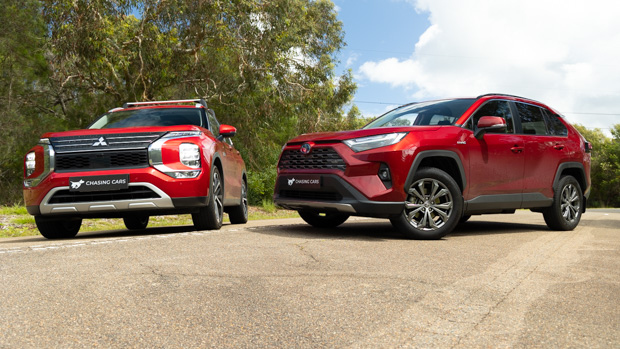
If you’re comparing these two there are other notable factors of course. For one thing, the RAV4 has lengthy wait lists but is quite affordable at $42,600 before on-roads in our as-tested GXL Hybrid FWD grade, and even after purchase buyers are presented with some of the cheapest servicing costs on the market.
Conversely, the Outlander PHEV Aspire is more expensive to buy at over $60K but you’ll get your hands on one a lot sooner. Curt also made the point that he far preferred the more refined and fair quieter hybrid system in Mitsubishi, and I can’t help but agree.
But at the end of the day the Mitsubishi has lost here, in what was a very fair experiment to measure efficiency; driving home the point that if you want to get the best out of this car, you really need to plug it in as often as possible.
Midsize SUVs are a huge hit among Australian families thanks to their versatility and good use of space, so how does the Outlander PHEV shape up in daily use?
Making a good car might seem fairly straight-forward; if you’re designing a sports car you give it lots of power and make the chassis handle well, while a big 4WD needs good ground clearance and traction, whereas a luxury car is all about quality and refinement.
But what about family cars? Well, in my experience, family cars are more about what you don’t notice, than what you do.
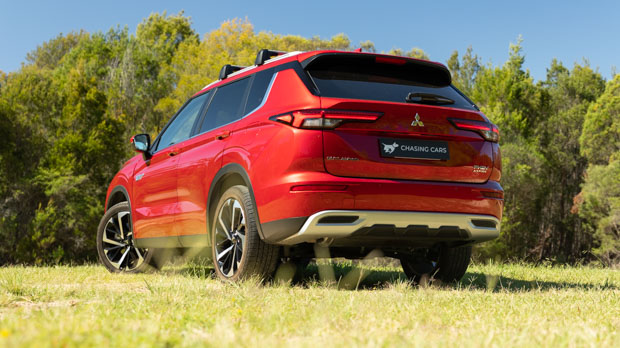
In my four months with the Outlander PHEV I’ve compared and contrasted it with a range of other vehicles and the most significant compliment I can offer this five-seater is that very few negatives come to mind when evaluating it as a family car.
I say “few” but definitely not “zero complaints”, so in this update I’m going to list some key positives I’ve found that have made the Outlander a great family car to live with and some other areas that really could be improved.
The Outlander is a big vehicle for a midsize SUV, so compared to something on the smaller end like a Subaru Forester (which still has great interior space) it’s 70mm longer, 47mm wider and 15mm taller. The big Mitsi doesn’t squander its size.
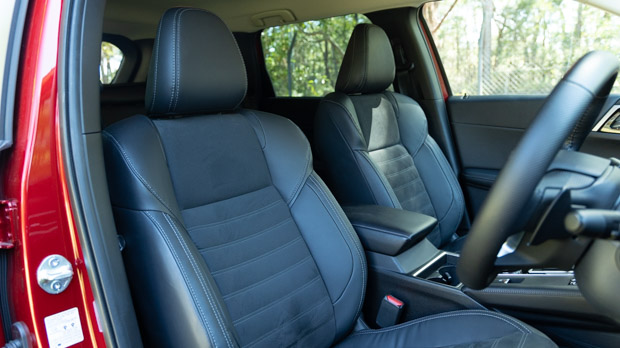
As a result, those up front benefit from great legroom and those in the back net similar levels of space, plus great visibility thanks to the raised height of the bench.
The specific advantage here though is the fact that it’s unlikely your front passenger will have to move their seat forward to squeeze in a rearwards-facing baby seat. Indeed, my (173cm tall) wife has left her passenger seat in her preferred position throughout our entire time with the Outlander.
But what about getting the bloody things in place?
Well, the Outlander has a lot going for it in this area, starting with rear doors that open to nearly 90 degrees, which is wide but not quite as wide as a Honda CR-V or indeed its sibling the Nissan X-Trail. But I’m really splitting hairs here, good is still good.
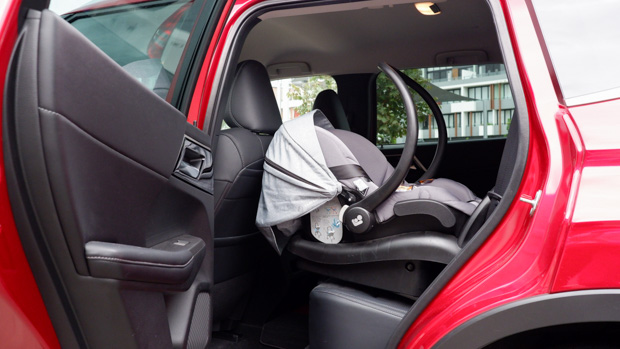
Match that with a relatively high roof line with a high cabin ceiling, enough room to squeeze a supporting leg in the footwell during fitment and easy-to-access top tether spots on the back of the outboard seats and I found I had a relatively easy time fitting babyseats in place.
Mitsubishi has clearly spent quite a bit of time thinking about how parents and children use the back seats in the real world and appropriately armed this space with a plethora of small but useful amenities.
The backseat pockets go beyond the usual big kangaroo pouch and feature a subset of smaller pockets at the top of the seats that we used to store spare nappies, wipes and other random but frequently used items during our recent road trip to Adelaide.
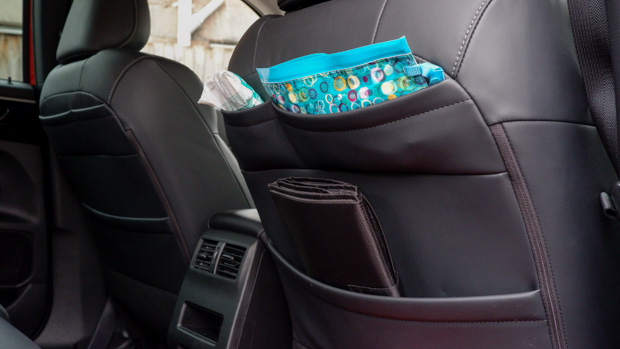
Those who opt for the Aspire PHEV grade also net tinted windows in the second row.
While you do miss out on pull-up sunshades, which are fitted to the Exceed and above variants, you can option them for an extra $552 and save yourself a few grand by not having to walk up variant grades.
In addition to the usual suite of USB ports, Mitsubishi offers the Aspire, Exceed and Exceed Tourer PHEV grades with a three-pin charging plug under the rear air vents (and in the boot) that has enough grunt behind it to charge up your devices at similar speeds to your home.
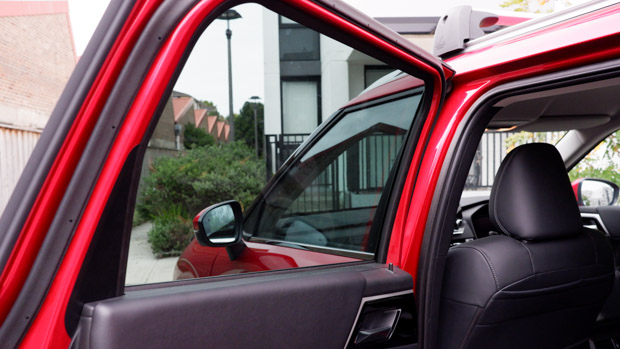
On several occasions, I’ve found myself in the back row of the Outlander with the air conditioning on, laptop plugged in and relaxed in my rather cosy makeshift mobile office.
In particular, I note one occasion were this connivence was quite the lifesaver for myself and office coordinator James Lisle, allowing us to escape the hot Australian sun while shooting an upcoming megatest.
If I was a contractor living much of my life out on the road, this feature alone would put the Outlander PHEV on my shortlist.
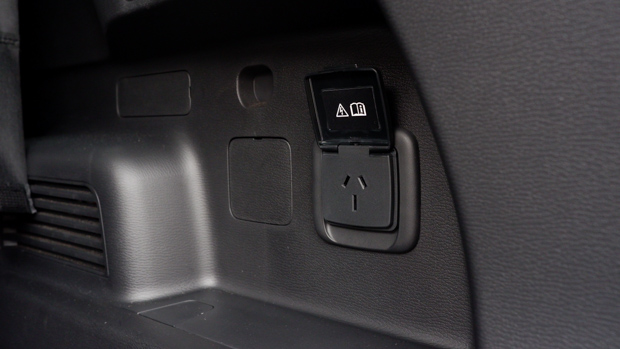
It’s been a few months now since the government made the baffling decision to allow me to become a parent, and if there is one thing I’ve noticed (aside from the sleep deprivation) it’s that I sure do cart a lot of crap around with me nowadays.
As a result, it takes a long time to pack the car before heading off, so I usually like to get the kiddo loaded into her throne before playing Tetris in the boot area.
With these hot summer days we’ve been having lately, it’s often necessary to start the engine to pump out the hot air, though in underground environments it’s also a great way to fill the cabin with fumes. Not ideal then.
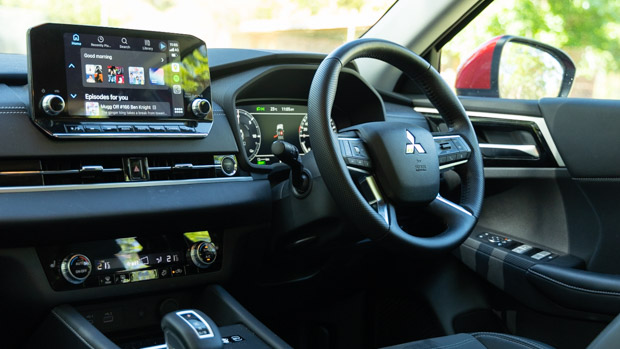
Enter the Outlander PHEV. As long as you’ve got a bit of juice in the battery the aircon can be pumping hard while the 2.4-litre engine sits idle.
Toyota hybrids can do this as well, but only for a fraction of the time that the Outlander can, likely due to the much larger battery size in the Mitsu.
I will note though, that I’d prefer if the air conditioning of the Outlander PHEV was a touch stronger for those seriously hot days.
As I’ve mentioned in previous updates, there have been times when I’ve hit the maximum boot capacity of my Outlander, and while, at 494L, it’s certainly not small in the Aspire PHEV, it could be a touch bigger.
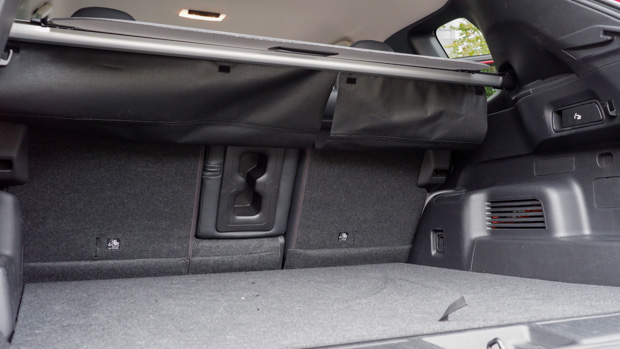
Also remember that the Outlander Aspire PHEV doesn’t have an extra set of seats like the Exceed and Exceed Tourer, a place to store the spare wheel under the floor or (much to my annoyance) for the cargo cover. So that usually lives in my garage.
The end result of this slight shortage of space is that on a few occasions, I’ve been forced to put goods elsewhere, such as on the roof racks during our interstate road trip, or in the backseat, as I did during a big shopping trip at the supermarket I did recently.
I say this with the caveat that if my child was older, and didn’t require a pram, I likely wouldn’t have run into these limitations.
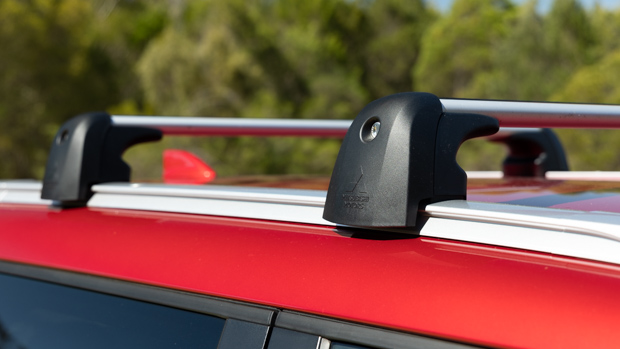
But the fact remains that rivals such as the Kia Sportage GT-Line petrol AWD (543L) and the smaller Subaru Forester 2.5i-S (498L) have bigger boots and a full-size spare to match, though, of course, neither of these two are hybrids.
All in all though, the Outlander PHEV has been a terrific ‘boring’ family car that still has enough zip in its step and smarts in its design that it’s been quite lovely to live with so far.
Having a small battery with a short driving range would make cross-country touring unviable for most electric vehicles – not so for the Outlander PHEV
In my first two months with the Mitsubishi Outlander PHEV one thing has quickly become apparent: some days this car makes a lot of sense, and other days, it doesn’t.
Driving home from work for the last time in 2022, it was one of those occasions where the Outlander PHEV seemed like a wise choice, as that day I completed my commute using cheap electric power and on the next, I would embark on a circa 1450km journey from Sydney to Adelaide.
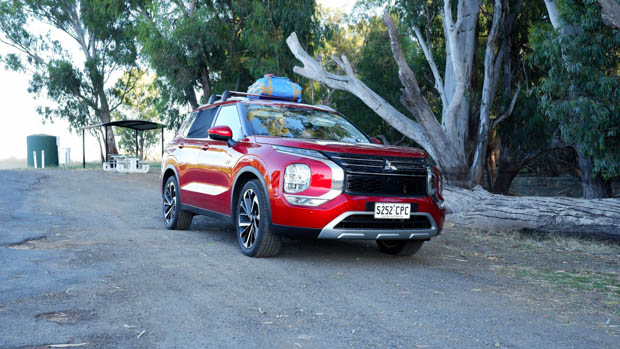
Could this lengthy journey be done in a fully electric vehicle? Sure, in the right car.
But having previously run out of juice in an MG ZS EV during a short sprint from Sydney to Canberra I’d be hesitant to leave myself and my family stranded due to a broken charger across our still limited charging network, with gaps of up to 280km along my chosen route.
Those who followed my time with my Subaru Outback will know this journey well, only this time I had a three-month-old baby and all her additional luggage joining my wife and dog Buddy on board.
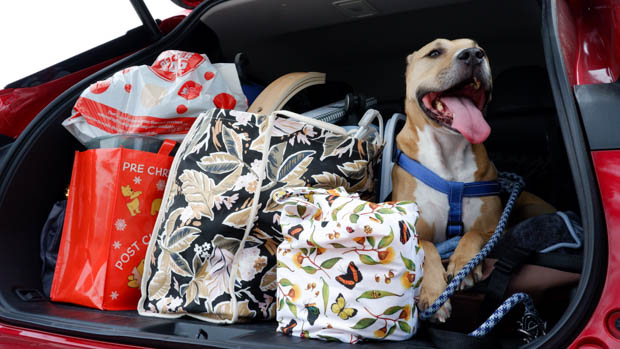
The added cargo saw us max out the 485L boot of the Outlander relatively quickly; the space itself was tall and featured several handy tie-down points, plus several handy storage locations elsewhere in the cabin for extra bits that needed to be more accessible.
Even still, it was necessary to strap our pram to the roof via Mitsubishi’s genuine accessory roof racks – which, I might add, were sturdy and easy to use.
Incredibly, we are able to get out onto the road in good time, and with a sleeping baby tucked in the back seat, I quickly came to appreciate the Outlander PHEV’s first major strength: its whisper-quiet drivetrain, courtesy of its dual electric motors, which allowed me to get up to highway speeds without filling the cabin with engine clatter.
Somehow the tarp-wrapped pram didn’t make much noise either – much to the relief of my partner and I – and the soft suspension combined with the couch-like seats immediately set a good tone for the hours ahead.
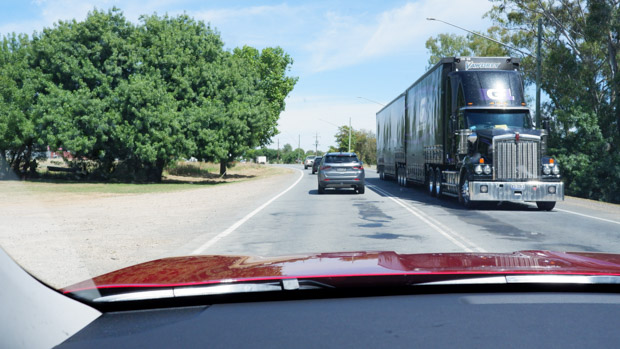
Having completed this trip with a number of cars over the years, I’ve come to the opinion that having a strong drivetrain sits high up on the list of desirable attributes of a grand tourer and the Outlander PHEV quite frankly pulls like a train.
A quick overtake performed in a visible area is the safest kind in my opinion and it was reassuring to have every bit of that 185kW/450Nm under my right foot, particularly so when the electric motors handed me the torque instantly.
Most of the time, however, I was simply driving in a straight line, and it’s here where I would have appreciated the steering assisting function, which is only available on the Exceed and Exceed Tourer grades.
The seats themselves could also use some finessing, as over time their couch-like comfort left me wanting for more posture support. However, I can’t say a bad word about the interior cabin space; as there was plenty of room to stretch out in both the front and back seats, with the latter also offering fantastic visibility.
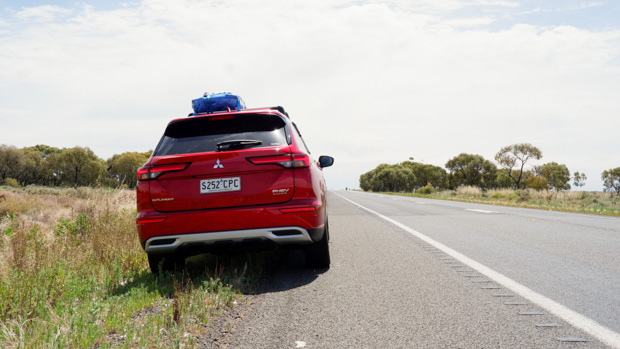
Take no notice of the sock-style window shades draped over the rear windows, a regrettable purchase of mine (as they fit horribly), but one that was necessary to keep the sun off our baby’s face in the hot summer conditions. The default tinting of the rear windows offers a better balance between temperature control and visibility, most of the time.
Mitsubishi offers roll-up window shades on the Exceed grade and above though also gives buyers the option to have it fitted for just $552 if buyers don’t feel paying the extra $5500 to jump up the next rung on the ladder – an admirable bit of flexibility from the Diamond brand.
My concerns continue for the wayward body control of the Outlander PHEV, which threw around my family and I more than it should’ve in the sharp high-speed bends, though thankfully this was only really an issue in South Australia and parts of Victoria.

The poor conditions of the roads meant that I quickly became acquainted with the local selection of potholes with one deceptively deep hole sending shockwaves throughout the cabin, no thanks to the 20-inch wheels with its slim tyres.
I quickly pulled over to inspect for any damage but the alloys held up well. And thank god for that as there is no spare (space saver or otherwise) in the back to pop on in case of an emergency.
For this reason, I’d strongly advise buyers to opt for the optional 18-inch wheels wrapped in chunkier rubber if they often find themselves heading out bush.
Starting with a full battery and driving in hybrid mode (as I would for the rest of the trip) the additional electric assistance trickled away at the 66km mark, though over time the Outlander PHEV appeared to retain the 20kWh battery to use for accessory power, rather than draining it right off the bat and switching to the 2.4-litre petrol engine.
With a three-month-old on board, it was necessary to break the trip into two days instead of our usual 15-hour slog, but this proved advantageous as we were able to start each of the four days of travel with a full battery.
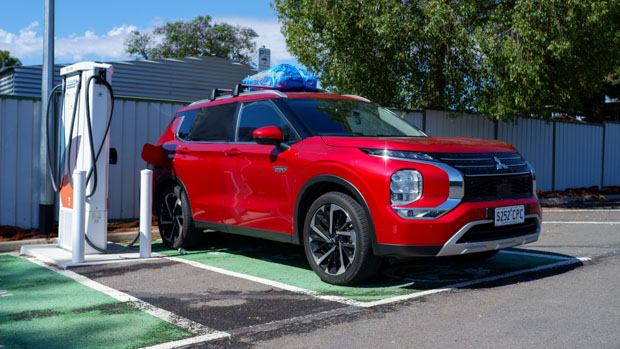
In total, I was able to supplement my fuel usage by recharging the Outlander nine times – four times on the way there and five on the way back – adding between 80 to 100 percent each time.
Determined not to drag out an already long trip, I did my best to synchronise baby nappy changes and lunch breaks with my nearest CHAdeMO fast charger, which was often placed in close proximity to toilets, supermarkets, cafes and often completely free; removing most of the hindrance of plugging in so frequently.
On the way there I used 7.57L/100km of either 91 or E10 fuel – whichever was available en route – supplemented with 57.68kWh of electricity, though on the trip back I used 8.65L/100km and 64.16kWh – with the extra consumption likely owing to the more heavily packed car and increased stoppages.
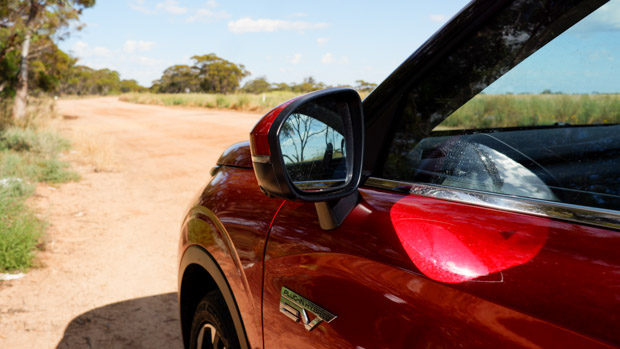
Considering that these numbers were recorded with a hulking big package on the roof destroying the aerodynamics, I think the Outlander PHEV earns a pass here and I plan to do more highway driving in the future to record some more meaningful numbers.
Nevertheless, these aren’t woeful numbers like we’ve seen from plug-in hybrids of the past, and I’d say that this trip has convincingly added another string to the Mitsubishi’s bow.
The Place family is getting broader and our needs more varied; so is the oddball Outlander PHEV actually a strike of brilliance for the modern family?
Earlier this year I embarked on a weekend away in our previous GWM Ute long-termer on a trip that sadly required it be filled upon return, and as the pump’s numbers rolled on by $120 all I could do was shake my head. It wasn’t even a full bloody tank.
It’s the small moments like these that make you look inwards to ways you can get through life on just a little bit less; a dim reality not helped by the fact that inflation has since spiked, the cost of rent is up and my partner and I have just welcomed a baby into our lives.

So when editor Tom Baker threw me the keys to my Outlander Aspire and I learned it was ‘the hybrid one’, you can bet I was excited. But to say this new model is just about saving money is really doing it a disservice.
Mitsubishi has really gone all-in on the styling of the fourth-gen Outlander and while I personally haven’t been able to determine if I like it or not, it’s a commendably bold design similar to the likes of the Kia Sportage. Neither will melt into traffic quite so easily.
That modernised design has carried through to an interior that features a design and a sense of quality I wasn’t expecting. The door tops are finished with soft leather, the touchscreen is a handy 9.0-inches in size and the intuitive controls feel solid and fall nicely to hand.
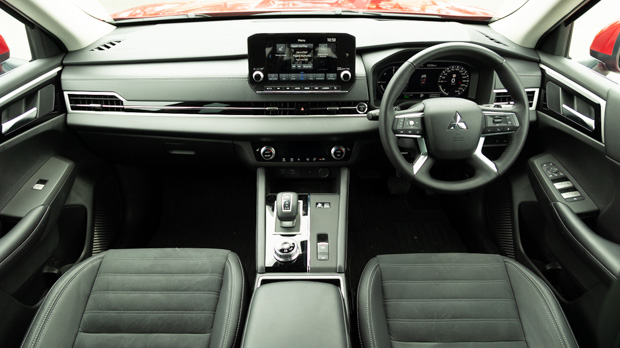
It also took me some time to find a feature this mid-spec Aspire didn’t have. However, my partner was quick to point out the lack of power adjustment on the front passenger side and the sweat-collecting nature of the combination suede and synthetic leather seats.
Most bizarre is the lack of wireless connectivity for Android phones when wireless Apple CarPlay is fitted as standard, making the wireless charger a bit redundant when I have to leave a cable plugged in anyway.
Though once I was plugged in and settled into those surprisingly comfortable seats, I confess I was quite surprised at how quick the Outlander PHEV is to drive – though with 185kW/450Nm and the benefit of instant torque from those electric motors, perhaps I shouldn’t have been.
While the non-hybrid Outlander I’d sampled prior felt controlled but quite harsh over bumps, the PHEV feels much softer in ride if more wayward in its body control, a fact not helped by the distinct lack of steering feel.
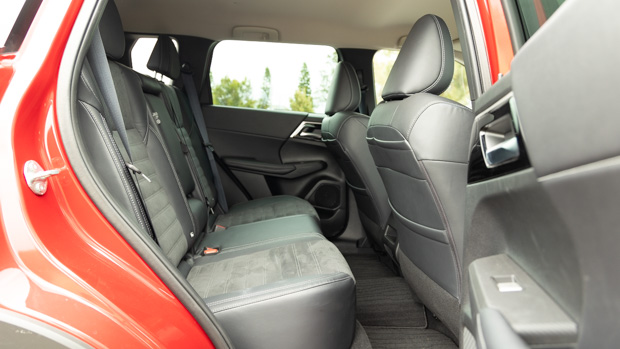
That’s a slightly disconcerting combination when you have all that grunt at your toe-tips, though the Outlander PHEV does claw back some handling points thanks to its Super All-Wheel-Control that uses torque vectoring by braking front and rear to tighten your driving line.
I plan to spend more time investigating the driving dynamics of the Outlander but for the most part, this big red bus will mostly serve in hauling my family around town while we tackle the daily challenges of life.
Among these is my bi-annual trip back home from Sydney to Adelaide, which will see my family venture into terrain not partial to EV chargers. It will be interesting to see how the fuel economy stacks up over the 14-15 hour trip in the summer heat.
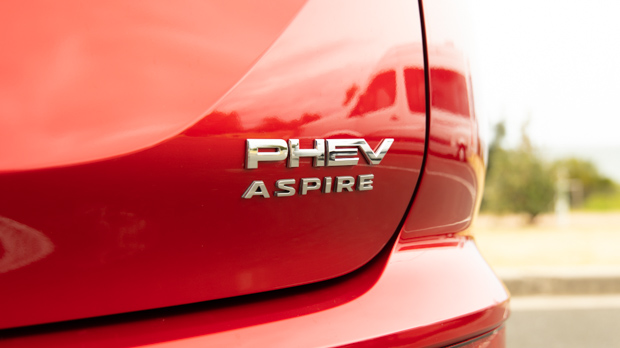
Day to day, though, I plan to keep the Outlander’s 20kWh battery topped up as much as possible to see how long it can go without using a drop of petrol.
Mitsubishi has also made much of the fact that the Outlander PHEV’s battery can be used as a mobile power supply, a claim I will put to the test during camping trips with friends and by using it as a mobile office when on the road.
All this and much more is on the way and if you have any questions or ideas feel free to reach out to us, but for now stay tuned as we’ll have another monthly instalment soon.
Key specs (as tested)
About Chasing cars
Chasing Cars reviews are 100% independent.
Because we are powered by Budget Direct Insurance, we don’t receive advertising or sales revenue from car manufacturers.
We’re truly independent – giving you Australia’s best car reviews.
The estimate provided does not take into account your personal circumstances but is intended to give a general indication of the cost of insurance, in order to obtain a complete quote, please visit www.budgetdirect.com.au. Estimate includes 15%^ online discount.
^Conditions Apply
Budget Direct Insurance arranged by Auto & General Services Pty Ltd ACN 003 617 909(AGS) AFSL 241 411, for and on behalf of the insurer, Auto & General Insurance Company Limited(ABN 42 111 586 353, AFSL 285 571).Because we don’t know your financial needs, we can’t advise you if this insurance will suit you. You should consider your needs and the Product Disclosure Statement before making a decision to buy insurance. Terms and conditions apply.
Indicative quote based on assumptions including postcode , 40 year old male with no offences, licence suspensions or claims in the last 5 years, a NCD Rating 1 and no younger drivers listed. White car, driven up to 10,000kms a year, unfinanced, with no modifications, factory options and/or non-standard accessories, private use only and garaged at night.
^Online Discounts Terms & Conditions
1. Discounts apply to the premium paid for a new Budget Direct Gold Comprehensive Car Insurance, Third Party Property Only or Third Party Property, Fire & Theft Insurance policy initiated online on or after 29 March 2017. Discounts do not apply to optional Roadside Assistance.
2. Discounts do not apply to any renewal offer of insurance.
3. Discounts only apply to the insurance portion of the premium. Discounts are applied before government charges, taxes, levies and fees, including instalment processing fees (as applicable). The full extent of discounts may therefore be impacted.
4. We reserve the right to change the offer without notice.